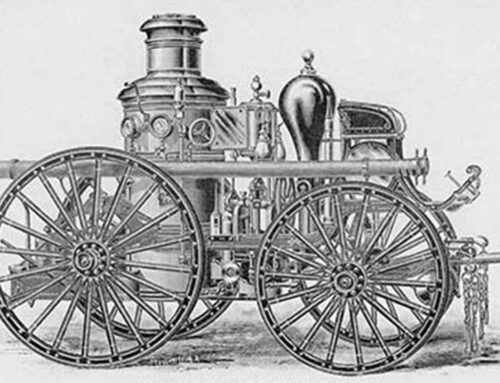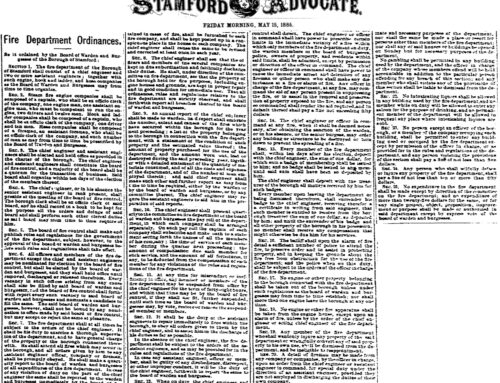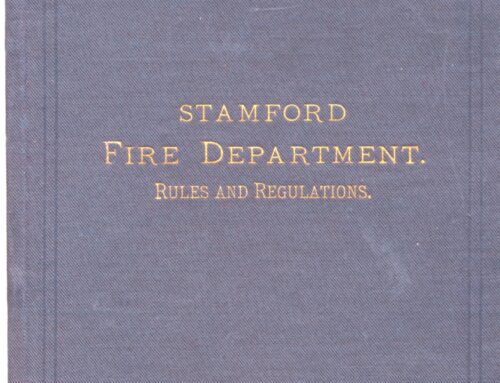By now Retired Firefighter Joseph F. Lombardo I
July 28, 1918, was a warm summer day in the City of Stamford and the weather
mirrored the mood of the people. World War I was drawing to a close, the Imperial
German Army was driven back in their last desperate gamble to seize Paris and win the
war. Now Marines and Soldiers under General Pershing were driving ahead into German
trench lines taking ground and inflicting huge losses. Stamford’s sons would soon be
coming home
Day was slowly ending under a gentle breeze when Police Officer Timothy
Kenefic saw smoke coming from the Acker, Merall, and Condit Company store. He ran
to the nearest alarm box and pulled it. At 5:30pm Box 23 for Atlantic St. was chattering
in all three downtown firehouses. Station turnout was faster than ever before due to the
S.F.D. fleet of apparatus now being completely motorized. This was well ahead of
progressive major city fire departments like Los Angeles and New York: those cities
would use horses until 1920 and 1922 respectively.
The S.F.D. arrived to smoke pushing out of the basement and front windows of
the store. Windows were broken out and hose lines were positioned to begin the attack.
Despite ventilation, conditions did not improve. The S.F.D. pushed in, knocking down all
the visible fire on the first floor, but the heart of the blaze was in the basement. The fire
was feeding on oils, canisters of ammonia, cases of liquor, and all the other items a
grocery store could carry. Sucking in one last breath of semi-clean air the S.F.D. pushed
into the basement led by Lt. Henry C. Dugdale and Captain James W. Smith.
Several desperate minutes passed as Chief Harry Parker watched for a sign his
men were gaining the upper hand, a hose pulled deeper into the building or the smoke to
turn from black to white. As he started toward the building to check on his men they
appeared before him pulling back their hoses before collapsing on the sidewalk in heaps
from smoke inhalation. Both officers and several firefighters were now out of action and
despite their attempts, the fire had returned to the first floor and was venting out the
windows.
Chief Parker ordered a second alarm to be struck bringing fire fighters from
Noroton, Darien, Springdale, Glenbrook, and Sound Beach to the scene. Help also came
from an unlikely source as soldiers from Edgewood Arsenal arrived. Curious by the
noise created by the engines screaming past the arsenal Lt. Jones put down his fork and
went to see what all the commotion was about with one of his NCO’s a soldier named
Charles Jugeman who in civilian life was a fire fighter in Erie, Pennsylvania. They
arrived on scene to see the first wave of fire fighters splayed out on the street suffering
from the effects of the toxic smoke. Lt. Jones offer of assistance was gratefully accepted
and he ordered Jugeman to get back to the arsenal. The NCO was to bring every
available man, gas masks, and medical supplies.
As the soldiers and S.F.D. fire fighters pulled on their gas masks and again
attempted to enter the basement with their hoses, mutual aid companies arrived ringing
the building. They were not a moment too soon and pressed into the basement as more
fire fighters went down. The masks, suited for trench warfare were not entirely effective
against the smoke of the fire. Liquor bottles and ammonia canisters continued to explode
sending glass flying through the basement cutting several men. Doctors from all over the
city arrived at the fire and rendered aid to those stricken sending the more serious cases to
Stamford Hospital. The Stamford Police were also out in force trying to control the
crowd that had gathered to watch the fire and act as stretcher bearers.
Seeing so many men down Chief Parker ordered a halt to the interior attack. He
directed companied to fight the fire from the cellar door and front sidewalk of the
building. Ten hoses lines were placed in service and the tremendous volume of water
poured into the building drowned the majority of the fire. Improved masks with 12-hour
cartridges were brought from the arsenal as the men gathered for the final push. Captain
Hyland was one of the few firefighters from the original box alarm who were still
standing despite being part of two previous attack waves in the basement. He donned his
new mask along with Chief Parker and they led the firefighters from five departments
and the soldiers into the basement once more. In a matter of minutes, the last of the
flames were doused and Chief Parker declared the fire under control, it was 9 pm. The
battle on Atlantic St. was over. The last units would not leave the scene until midnight.
The toxic smoke exacted a high toll on the S.F.D.. Lt. Dugdale was hospitalized
for several days. Captain Smith his eyes swollen and bandaged was confined to his home
along with eight other firefighters. The resulting lingering sickness that afflicted these
and other men forced the closing of 3co. for almost a month due to manpower shortages.





